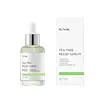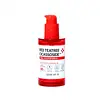What's inside
What's inside
 Key Ingredients
Key Ingredients

 Benefits
Benefits

 Concerns
Concerns

No concerns
 Ingredients Side-by-side
Ingredients Side-by-side

Melaleuca Alternifolia Leaf Water
AntimicrobialCentella Asiatica Leaf Water
Skin ConditioningButylene Glycol
HumectantNiacinamide
SmoothingGlycereth-26
HumectantWater
Skin ConditioningCentella Asiatica Extract
CleansingSodium Hyaluronate
HumectantGlycerin
Humectant1,2-Hexanediol
Skin ConditioningBetaine
HumectantCaprylyl Glycol
EmollientPortulaca Oleracea Extract
Skin ConditioningBrassica Oleracea Italica Extract
AstringentMedicago Sativa Extract
TonicBrassica Oleracea Capitata Leaf Extract
Skin ConditioningTriticum Vulgare Germ Extract
Skin ConditioningBrassica Campestris Extract
Skin ConditioningRaphanus Sativus Seed Extract
Skin ConditioningCellulose Gum
Emulsion StabilisingAllantoin
Skin ConditioningBeta-Glucan
Skin ConditioningEthylhexylglycerin
Skin ConditioningAdenosine
Skin ConditioningDipotassium Glycyrrhizate
HumectantXanthan Gum
EmulsifyingPentylene Glycol
Skin ConditioningAspalathus Linearis Extract
Skin ConditioningGlycyrrhiza Glabra Root Extract
BleachingChlorophyllin-Copper Complex
AntioxidantCommiphora Myrrha Resin Extract
Skin ConditioningPerilla Frutescens Leaf Extract
MaskingYucca Schidigera Root Extract
Skin ConditioningMelaleuca Alternifolia Leaf Water, Centella Asiatica Leaf Water, Butylene Glycol, Niacinamide, Glycereth-26, Water, Centella Asiatica Extract, Sodium Hyaluronate, Glycerin, 1,2-Hexanediol, Betaine, Caprylyl Glycol, Portulaca Oleracea Extract, Brassica Oleracea Italica Extract, Medicago Sativa Extract, Brassica Oleracea Capitata Leaf Extract, Triticum Vulgare Germ Extract, Brassica Campestris Extract, Raphanus Sativus Seed Extract, Cellulose Gum, Allantoin, Beta-Glucan, Ethylhexylglycerin, Adenosine, Dipotassium Glycyrrhizate, Xanthan Gum, Pentylene Glycol, Aspalathus Linearis Extract, Glycyrrhiza Glabra Root Extract, Chlorophyllin-Copper Complex, Commiphora Myrrha Resin Extract, Perilla Frutescens Leaf Extract, Yucca Schidigera Root Extract
Melaleuca Alternifolia Leaf Extract
PerfumingButylene Glycol
HumectantPropanediol
Solvent1,2-Hexanediol
Skin ConditioningNiacinamide
SmoothingWater
Skin ConditioningPolyglyceryl-10 Laurate
Skin ConditioningCarbomer
Emulsion StabilisingArginine
MaskingGlycerin
HumectantEclipta Prostrata Extract
Skin ConditioningCoccinia Indica Fruit Extract
Skin ConditioningEthylhexylglycerin
Skin ConditioningCellulose Gum
Emulsion StabilisingAdenosine
Skin ConditioningCamellia Sinensis Leaf Extract
AntimicrobialMelaleuca Alternifolia Leaf Oil
AntioxidantGlycyrrhiza Glabra Root Extract
BleachingAgrimonia Eupatoria Extract
AstringentDisodium EDTA
Perilla Frutescens Leaf Extract
MaskingLactobionic Acid
BufferingSilybum Marianum Seed Extract
Skin ConditioningBeta-Glucan
Skin ConditioningBroussonetia Kazinoki Root Extract
Skin ConditioningPropolis Extract
Skin ConditioningCimicifuga Dahurica Root Extract
AntioxidantSalix Alba Bark Extract
AstringentPentylene Glycol
Skin ConditioningOenothera Biennis Flower Extract
AstringentMadecassoside
AntioxidantCitric Acid
BufferingSodium Carbomer
Emulsion StabilisingPolyacrylate Crosspolymer-6
Emulsion StabilisingT-Butyl Alcohol
PerfumingHydroxycinnamic Acid
Skin ConditioningRutin
AntioxidantMelaleuca Alternifolia Leaf Extract, Butylene Glycol, Propanediol, 1,2-Hexanediol, Niacinamide, Water, Polyglyceryl-10 Laurate, Carbomer, Arginine, Glycerin, Eclipta Prostrata Extract, Coccinia Indica Fruit Extract, Ethylhexylglycerin, Cellulose Gum, Adenosine, Camellia Sinensis Leaf Extract, Melaleuca Alternifolia Leaf Oil, Glycyrrhiza Glabra Root Extract, Agrimonia Eupatoria Extract, Disodium EDTA, Perilla Frutescens Leaf Extract, Lactobionic Acid, Silybum Marianum Seed Extract, Beta-Glucan, Broussonetia Kazinoki Root Extract, Propolis Extract, Cimicifuga Dahurica Root Extract, Salix Alba Bark Extract, Pentylene Glycol, Oenothera Biennis Flower Extract, Madecassoside, Citric Acid, Sodium Carbomer, Polyacrylate Crosspolymer-6, T-Butyl Alcohol, Hydroxycinnamic Acid, Rutin
Alternatives
Ingredients Explained
These ingredients are found in both products.
Ingredients higher up in an ingredient list are typically present in a larger amount.
1,2-Hexanediol is a synthetic liquid and another multi-functional powerhouse.
It is a:
- Humectant, drawing moisture into the skin
- Emollient, helping to soften skin
- Solvent, dispersing and stabilizing formulas
- Preservative booster, enhancing the antimicrobial activity of other preservatives
Adenosine is in every living organism. It is one of four components in nucleic acids that helps store our DNA.
Adenosine has many benefits when used. These benefits include hydrating the skin, smoothing skin, and reducing wrinkles. Once applied, adenosine increases collagen production. It also helps with improving firmness and tissue repair.
Studies have found adenosine may also help with wound healing.
In skincare products, Adenosine is usually derived from yeast.
Learn more about AdenosineBeta-Glucan is a polysaccharide. It can be derived from the cell walls of seaweed, oats, yeast, and fungi. It hydrates the skin and helps boost your skin's natural barrier.
As an antioxidant, beta-glucan helps fight free-radicals. Free-radicals are molecules that may damage your skin cells, such as pollution.
Studies show this ingredient may be an effective wrinkle reducer as it can deeply penetrate into skin. It has also been show to help with wound healing.
Learn more about Beta-GlucanButylene Glycol (or BG) is used within cosmetic products for a few different reasons:
Overall, Butylene Glycol is a safe and well-rounded ingredient that works well with other ingredients.
Though this ingredient works well with most skin types, some people with sensitive skin may experience a reaction such as allergic rashes, closed comedones, or itchiness.
Learn more about Butylene GlycolCellulose Gum is a water-soluble polymer that comes from cellulose. It is used to change the texture of a product and to help stabilize emulsions.
As an emulsifier, cellulose gum specifically thicken the texture of water-based products.
This ingredient is considered hypoallergenic and non-toxic. Cellulose Gum can be found in cosmetics, food, and other household goods such as paper products.
Learn more about Cellulose GumEthylhexylglycerin (we can't pronounce this either) is commonly used as a preservative and skin softener. It is derived from glyceryl.
You might see Ethylhexylglycerin often paired with other preservatives such as phenoxyethanol. Ethylhexylglycerin has been found to increase the effectiveness of these other preservatives.
Glycerin is already naturally found in your skin. It helps moisturize and protect your skin.
A study from 2016 found glycerin to be more effective as a humectant than AHAs and hyaluronic acid.
As a humectant, it helps the skin stay hydrated by pulling moisture to your skin. The low molecular weight of glycerin allows it to pull moisture into the deeper layers of your skin.
Hydrated skin improves your skin barrier; Your skin barrier helps protect against irritants and bacteria.
Glycerin has also been found to have antimicrobial and antiviral properties. Due to these properties, glycerin is often used in wound and burn treatments.
In cosmetics, glycerin is usually derived from plants such as soybean or palm. However, it can also be sourced from animals, such as tallow or animal fat.
This ingredient is organic, colorless, odorless, and non-toxic.
Glycerin is the name for this ingredient in American English. British English uses Glycerol/Glycerine.
Learn more about GlycerinGlycyrrhiza Glabra Root Extract is an extract of the roots of Licorice. It has been found to have several benefits such as skin hydrating, conditioning, and soothing.
One component, glabridin, has extra potent antioxidant and soothing properties. It has also been found to block pigmentation from UVB rays in guinea pigs.
Licorice Root also contains a flavonoid. Flavonoids are a natural substance from in plants. Flavonoids also have antioxidant properties.
Another component, glycyrrhizin, has been found to have anti-inflammatory and antimicrobial benefits. This may make licorice root extract effective at treating acne. However, more research is needed to support this.
Liquiritin is one of the flavone compounds found in licorice. It has been found to help lighten skin by preventing tyrosinase from reacting with tyrosine. When the two react, protein is converted to melanin. Melanin is the substance in your body that gives your features pigmentation.
Learn more about Glycyrrhiza Glabra Root ExtractNiacinamide is a multitasking form of vitamin B3 that strengthens the skin barrier, reduces pores and dark spots, regulates oil, and improves signs of aging.
And the best part? It's gentle and well-tolerated by most skin types, including sensitive and reactive skin.
You might have heard of "niacin flush", or the reddening of skin that causes itchiness. Niacinamide has not been found to cause this.
In very rare cases, some individuals may not be able to tolerate niacinamide at all or experience an allergic reaction to it.
If you are experiencing flaking, irritation, and dryness with this ingredient, be sure to double check all your products as this ingredient can be found in all categories of skincare.
When incorporating niacinamide into your routine, look out for concentration amounts. Typically, 5% niacinamide provides benefits such as fading dark spots. However, if you have sensitive skin, it is better to begin with a smaller concentration.
When you apply niacinamide to your skin, your body converts it into nicotinamide adenine dinucleotide (NAD). NAD is an essential coenzyme that is already found in your cells as "fuel" and powers countless biological processes.
In your skin, NAD helps repair cell damage, produce new healthy cells, support collagen production, strengthen the skin barrier, and fight environmental stressors (like UV and pollution).
Our natural NAD levels start to decline with age, leading to slower skin repair, visible aging, and a weaker skin barrier. By providing your skin niacinamide, you're recharging your skin's NAD levels. This leads to stronger, healthier, and younger looking skin.
Another name for vitamin B3 is nicotinamide. This vitamin is water-soluble and our bodies don't store it. We obtain Vitamin B3 from either food or skincare. Meat, fish, wheat, yeast, and leafy greens contain vitamin B3.
The type of niacinamide used in skincare is synthetically created.
Learn more about NiacinamidePentylene glycol is typically used within a product to thicken it. It also adds a smooth, soft, and moisturizing feel to the product. It is naturally found in plants such as sugar beets.
The hydrophilic trait of Pentylene Glycol makes it a humectant. As a humectant, Pentylene Glycol helps draw moisture from the air to your skin. This can help keep your skin hydrated.
This property also makes Pentylene Glycol a great texture enhancer. It can also help thicken or stabilize a product.
Pentylene Glycol also acts as a mild preservative and helps to keep a product microbe-free.
Some people may experience mild eye and skin irritation from Pentylene Glycol. We always recommend speaking with a professional about using this ingredient in your routine.
Pentylene Glycol has a low molecular weight and is part of the 1,2-glycol family.
Learn more about Pentylene GlycolWe don't have a description for Perilla Frutescens Leaf Extract yet.
Water. It's the most common cosmetic ingredient of all. You'll usually see it at the top of ingredient lists, meaning that it makes up the largest part of the product.
So why is it so popular? Water most often acts as a solvent - this means that it helps dissolve other ingredients into the formulation.
You'll also recognize water as that liquid we all need to stay alive. If you see this, drink a glass of water. Stay hydrated!
Learn more about Water